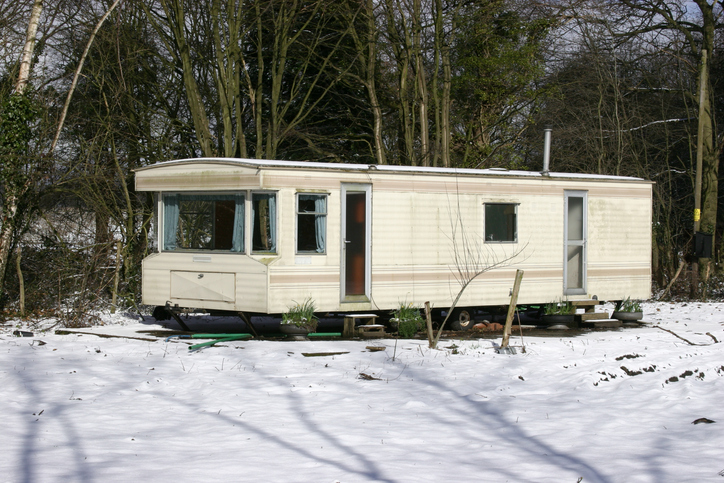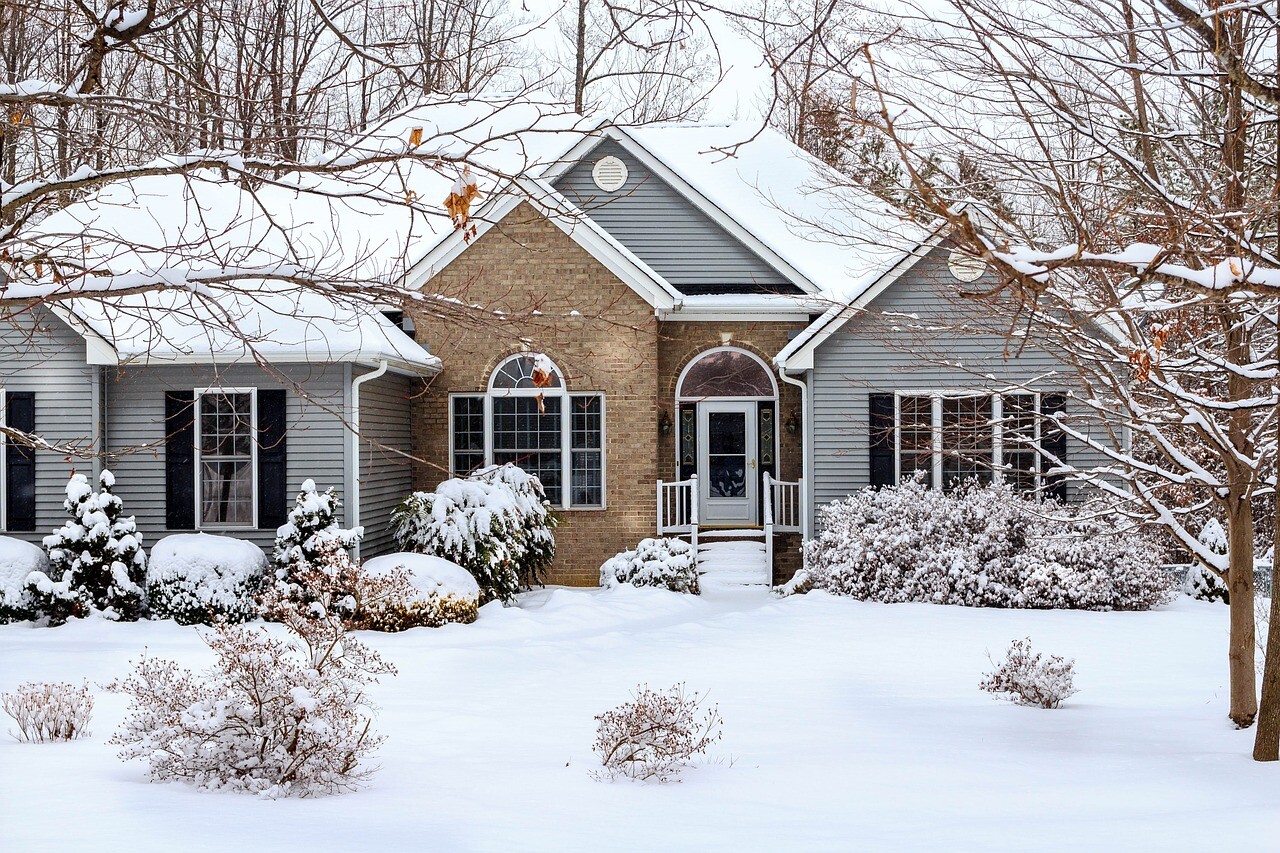Winter is made of cold weather that comes with frost and snow. Even when winter is far off, you should take the relevant measures and prepare for it.
You could be asking yourself, what are some of the budget-friendly ways to get ready for winter? Here, we’ll take you through approaches you can employ to winterize your mobile home.
How to Get Your Mobile Home Ready for Winter
There are at least three main objectives to achieve while winterizing your mobile home, which include:
- To restrict hot air from escaping using proper insulation
- To restrict cold air from coming into your manufactured home
- To prevent water and plumbing pipes from freezing over
Below are some of the approaches you can employ to winterize your manufactured home:
Roof Insulation
We all know that hot air only travels upwards. You can imagine how disappointing it would be to run heaters during the winter in your mobile home only for the warm air to escape through your uninsulated roof.
Most of the roofs in mobile homes are either uninsulated or poorly insulated. In most cases, there is a cavity between the ceiling and the roof that is left empty.
Even before you insulate your roof, you should do the following:
- Identify the amount of open space that you should insulate
- Install insulation baffles in your roof for ventilation
- Close gaps in your ceiling, especially near the water heater and furnace
Installing Roof Insulation
There are at least three manufactured home roof insulation methods:
- Interior Blow: This points to the interior of your manufactured home. Here, you drill holes in the ceiling, at particular points, between the rafters. You can then pump insulation materials into the cavity.
- Edge Blow: It’s also referred to as lifting the lid. This method involves loosening your roof from the manufactured unit and lifting it to pump in the insulation. You should implement it one truss bay at a time.
- Ridge Blow: Here, work is done on top of the roof. The insulation is also implemented one truss at a time. The benefit here is that it doesn’t affect the interior of your ceiling.
When you’re insulating your roof, you should apply spray foam to seal off any seams in the roof, especially when it comes to metal roofs.
It would also be best if you caulk around any plumbing and gutters that go through it. Doing regular maintenance will make your roof durable through the harsh winter months.

Proper Plumbing Practices
Plumbing should be a top priority for anyone who wants to winterize their mobile home. Plumbing fixtures in mobile homes are likely to freeze during cold winters.
A freezing pipe can lead to permanent damage. It can also interrupt the supply of water to the mobile home. You might be forced to do a costly plumbing system replacement and repair.
Draining Water from the Plumbing
Follow the below steps, if you plan to leave your house for a while in winter, to drain the water:
- Shut off the water pump, water heater, and main water valve.
- Open every faucet and tap in your mobile home systematically. This will prevent air vacuum & air pockets.
- Apply an air compressor to blow water from the pipes.
- Check whether the water heater tank has a floor drain. If it doesn’t, you’ll have to attach a hosepipe to the valve. Please open it and leave it to run until it’s empty.
- Head to the holding tank and drain the water completely.
- Flush the toilet until the bowl becomes empty. You can apply antifreeze for extra precaution.
Prevent Freezing Pipes
This is a long-term solution and is perfect when you plan on occupying your home through the winter.
At this point, you should give your manufactured home’s underbelly more attention. Below are some of the things you need to do to prevent freezing pipes:
Replace Your Manufactured Home Pipes
Rubber and plastic pipes are cheaper to replace if damaged, and they are more resistant to freezing water. You can, therefore, replace all of your metal and copper pipes with rubber or plastic ones.
Insulate Pipes
Insulating pipes is one of the most straightforward exercises you can do. You should buy fiberglass or rubber insulation pipe wraps. Place them around your pipes and tie them using acrylic, aluminum foil wrap, duct tape, and cable ties.
Insulate the Crawl Space and Repair Your Skirting
If there is no skirting in your manufactured home, you should invest in it. Inspect the skirting vents, entry places around the manufactured home, and skirting to ensure that they’re undamaged and secure.
You can then fix or replace individual panels using metal sheets or vinyl-based on your skirting material. When winter approaches, ensure that you shovel snow and ice away from your skirting.
You can also block open spaces using cardboard or wood and insulate the area with an insulating material.
Run Water Regularly
Since the winter still has a high chance of causing freezing pipes, running water is the solution. You should, therefore, run a faucet on every part of your home regularly.
Hose Bibs
Hose bibs are often ignored, but could burst. Make sure you insulate them and run them dry.
Heat Tape
Using heat tape is a very effective way of insulating pipes. However, in most cases, using heat tape may cause a fire. You should, therefore, understand the safety of using heat tape before installing it.
Service Your Manufactured Home Furnace
During winter, you must have a functional furnace in place. However, the furnace should also not combust from overuse.
Servicing the furnace involves doing furnace maintenance tasks that include replacing exhaust vents and furnace filters, along with servicing permanent filters.
Most modern furnaces contain systems that show when something is wrong, and the exact place where an error is.
Additionally, if you clean your roof vent regularly, the furnace won’t clog up with snow.
Make You Manufactured Home Doors and Windows Energy-Efficient
There are several ways of making the doors and windows energy-efficient, including weather stripping. These options keep hot air in your home and the cold air outside:
- Storm Windows: Replace the windows with storm windows since they have increased heat-efficiency and durability. They prevent heat loss.
- Double–Pane Windows: They are two windows with air in between. Try implementing them.
- Energy–Efficient Window Frames: Use windows that have WERS labels since they prevent air from entering or escaping your home. Such window frames are energy-efficient.
- Window Film: This solution is among the best you can implement.
- Identify Gaps: Identify visible leaks and seal them off by using weather strips or caulk.
- Employ Energy–Efficient Doors: These doors are fully or half-glazed with argon or glass.
- Storm Doors: They come in different sizes and materials. Go for steel, fiberglass, or aluminum types since they require low maintenance.
Add Insulation in the Floor
This process is straightforward and will help you keep the interior of your home warm during winter. It also helps in preventing your pipes from freezing.
You need the following things to achieve the insulation process:
- Duct tape
- Some silicone sealant
- Tools for pipework
- An insulation material having a decent R-value
- Staple gun
Follow through the steps below to complete the process:
- Buy enough insulation
- If necessary, remove pipes from your manufactured home
- Use the staple gun to fix the insulation under your floor
- Put back your pipes
- Finish the process by applying silicone sealant
Block Holes
At this time, you should have taken care of the doors, windows, and roof. However, there might be tiny holes in your mobile home that might let in or out the air.
Look for holes in your home and block them. Places to look for these holes include:
- Electrical outlets
- Plumbing entry points
- Wall strips or seams
- Doors and Windows
- Corners of the ceiling or floor
Relax the Tie Downs
It is a fact that there are ground freezes during winter, as a result of it’s contraction. The ground experiences a ground heave, which involves it shifting as much as three inches during the winter.
Contractors take such effects into account while installing foundations in mobile homes.
If there is no slack in your mobile home’s tie-downs, the ground could cause problems when it contracts.
You should, therefore, relax the tie downs to offer your home some breathing space.
Fireplaces and Chimneys
If you have either a fireplace or chimney in your home, you can buy and install a glass door or rubber-sealed damper that keeps cold air away.
Always keep fire safety in mind.
Ceiling Fans
As we have seen before, hot air always rises. You should, therefore, keep your ceiling fan rotating clockwise to force the hot air back down. This will always keep the mobile home warm during winter.
Clean Your Mobile Home Gutters
Dirty gutters can be overburdened if trapped ice, snow, or water gets into the mix. They get trapped either in the water heater roof caps, gutters, or furnace.
To solve this problem, you should clean the gutters before the winter weather begins to prevent the snowball effect.
Clear Water from Sprinklers and Hose
You should also clean sprinklers and hoses to remove any water. This will prevent them from spreading the freezing water to internal plumbing and, thus, preventing any possible damage.
Conclusion
As we have seen above, winterizing your mobile home in preparation for the winter weather is a very straightforward process that you can achieve by yourself.
The main aim should be preventing hot air from escaping your manufactured home and restricting cold air from entering the home.
When winter approaches, ensure that you shovel snow and ice away from your skirting. Weather stripping is also an important practice.
This means you must insulate the roof, perform proper plumbing practices, service the furnace, block holes, and more.
If you can’t do the above things, contact a professional plumber to help you out.









